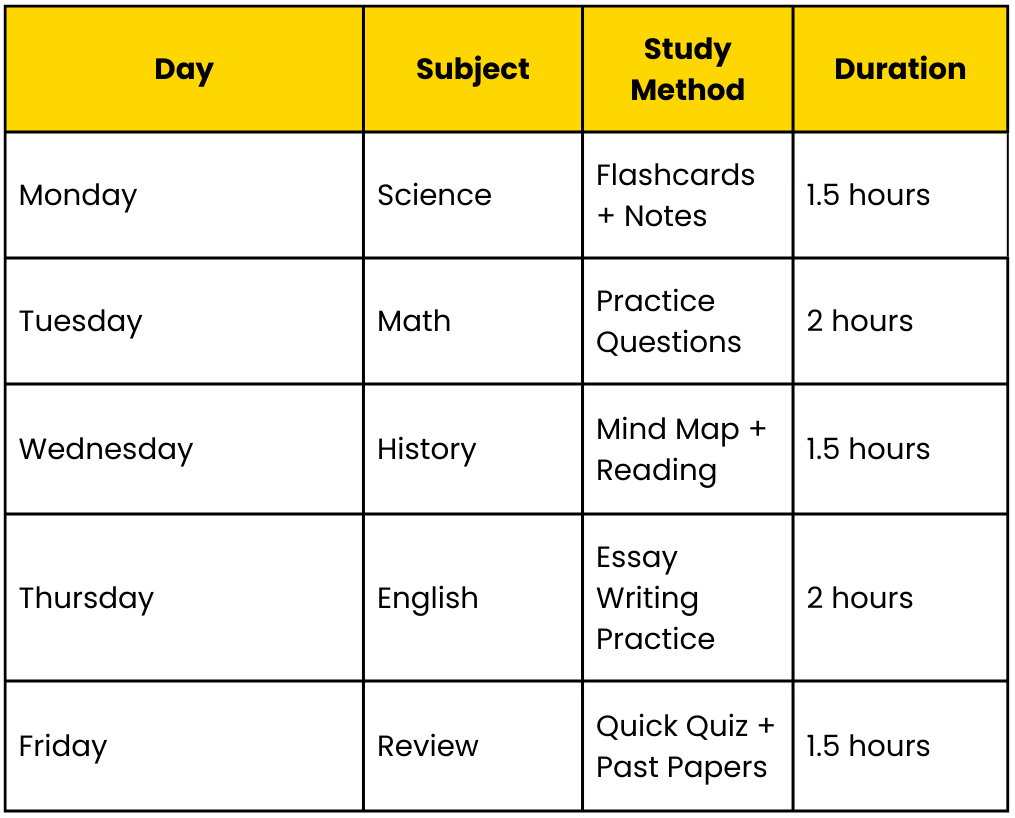How to create a study plan in 5 easy steps so you ace those exams
"A goal without a plan is just a wish." – Antoine de Saint-Exupéry

Have you ever sat down to study and felt completely overwhelmed? Maybe you don’t know where to start, or you waste hours "studying" without actually remembering anything.
The secret to exam success isn’t just about studying harder—it’s about studying smarter. That’s where a study plan comes in.
With the right strategy, you can stay organized, reduce stress, and maximize your learning time. And the best part? You don’t need to spend hours figuring it all out—I’ve done the hard work for you!
In this post, I’ll walk you through a simple 5-step system to create an effective study plan that actually works. Follow these steps, and you’ll be well on your way to acing your exams with confidence.
Step 1: Set Clear, Achievable Goals

🔹 Many students fail to study effectively because they don’t define what success looks like.
🔹 Instead of saying, “I want to pass my exam,” try setting specific and measurable goals, such as:
Score at least 80% on my final test
Memorize 30 key concepts before exam day
Complete 5 past papers in full
🔹 Use the SMART goal method to set better study targets:
Specific – Clearly define what you need to accomplish
Measurable – Have a way to track progress
Achievable – Be realistic with your time and ability
Relevant – Make sure your goal aligns with your exam
Time-bound – Set a deadline
📌 Quick fix: Write down your main study goal on a sticky note and put it somewhere visible. This will remind you to stay focused!
Step 2: Know Your Exam Format and Key Topics

🔹 Before diving into study mode, get crystal clear on:
The exam structure (multiple-choice, essays, problem-solving?)
Weight of each section (what carries the most marks?)
Core topics you need to master
🔹 A great way to do this is by checking past papers, asking your teacher, or reviewing your syllabus.
🔹 Once you have this info, prioritise your study time based on:
High-weighted topics = More study time
Weak areas = Extra practice
Strengths = Quick refresh
Step 3: Create a Study Schedule That Works for YOU
🔹 Consistency beats cramming! Spacing out study sessions helps memory retention (based on The Spacing Effect in psychology).
🔹 Decide how many hours per day/week you can realistically study.
🔹 Use the Pomodoro Technique (25 min study + 5 min break) for focused, efficient learning.
🔹 Keep a study planner to track your progress—digital or paper, whatever works best for you.
💡 Example Study Schedule (for a 2-week plan):

📌 Quick fix: Keep your study plan realistic—schedule breaks and rewards so you don’t burn out.
Step 4: Use the Right Study Techniques for Maximum Retention

Not all study methods are created equal! Instead of passively re-reading notes, use active learning techniques to lock in information faster.
🔹 Best techniques for exam success:
🎯 Mind Mapping – Helps visually connect ideas (great for essays & concepts)
🎧 Teach Someone Else – If you can explain it clearly, you know it well
✍️ Practice Retrieval – Test yourself with past papers & quizzes
📌 The Feynman Technique – Simplify complex topics by breaking them down into simple explanations
📌 Quick fix: Choose one new study technique to try today—start small and build on it.
Step 5: Track Progress and Adjust Your Plan

🔹 Review your progress every 3-4 days—what’s working? What’s not?
🔹 Identify weak areas and adjust your focus accordingly.
🔹 Stay flexible—life happens, and your plan should adapt when needed.
🔹 Use a Study Reflection Journal to note challenges, improvements, and key takeaways.
💡 Example Weekly Check-In:
✔ What topics do I feel confident in?
✔ What do I still struggle with?
✔ Am I sticking to my schedule?
✔ What needs to change next week?
📌 Quick fix: Use tick lists or a simple tracking system to measure progress and stay motivated.
Final Thoughts: You’ve Got This!
By following this 5-step study plan, you’ll be well-prepared to ace your exams without stress or burnout.
Key takeaways:
✅ Set clear goals
✅ Know your exam format & key topics
✅ Create a realistic study schedule
✅ Use active learning techniques
✅ Track progress & adjust as needed
🎉 Want to take your study skills to the next level?
🎉 Join The Million Mind Map Newsletter today for your weekly round-up of expert tips and be the first to hear all the latest from Mind Mapping Expert HQ.
📢 Let’s chat! What’s your biggest struggle when it comes to studying? Drop a comment below—I’d love to help! ⬇️

Categories

THE PROJECT
(2)

MIND MAPPING
(2)

JOIN IN
(2)

Latest Posts

About me

Hi there 👋 My name is Elaine Colliar, 5 Times World Mind Mapping Champion and your Mentor in Mind Mapping!

Ready to Think Smarter? Join Our Free Mind Mapping Community!
Learn directly from TWO World Champions in Mind Mapping, get exclusive resources, and connect with like-minded thinkers who are transforming their productivity, careers, and creativity.

Get Smarter, One Weekly Idea at a Time
We simplify all our Mind Mapping news for you. Get the week's best insights, tips and news—all curated and delivered in one weekly digest. Organise your thinking, unlock creativity, and achieve more with less effort.



